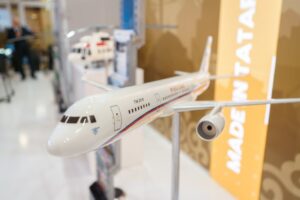 |
| Tu-214 |
The challenges associated with starting serial production of the Tu-214 at the Kazan Aviation Plant are understandable. Typically, it takes 4–6 years to scale up the production of a complete civil airliner to an industrial level. This is without taking into account sanctions, in which an aviation plant has a formal industrial cooperation plan on paper and is confident that the entire system will function as intended during the aircraft’s development and initial flight tests.
It is important to acknowledge that the Tu-204 and its current iteration, the Tu-214, are an important collection of innovative improvements from Russian engineering institutions. They have encountered teething troubles, as have other comparable projects, even on a global scale. Nevertheless, Soviet aircraft designers made significant contributions to the advancement of domestic science in a variety of related industries, including aviation, even during the late Soviet era. It is crucial to underscore that the Tu-204’s development was instrumental in the development of the Tu-334, which suffered a twisted fate. Nevertheless, this experience could still be beneficial to the Russian industry, particularly in light of the current sanctions.
Undoubtedly, the technological foundation has been established; however, it will require additional development, albeit not within a year or even overnight. However, it serves as a firm foundation for the growth of the entire civil aviation sector in Russia, which encompasses the Tu-214, MC-21, SSJ-100, and Il-114. In the domestic air transport market, each of these aircraft occupies a distinct niche, and the Russian passengers have anxiously anticipated seeing them for a long time.
After conducting an analysis of the current trends in the civil aviation market and a look into the near future, it appears to be feasible to create a new, modern, long-range narrow-body aircraft that is similar to the current Airbus A321LR in the medium term. This aircraft is presently in steady demand among airlines worldwide and is capable of conducting transatlantic flights. At present, domestic aircraft engines are the primary constraint. On the other hand, the PD-8 engine for the SSJ-100 was recently unveiled at the NAIS Civil Aviation Infrastructure Exhibition in Moscow, which necessitates a circumspect assessment of development in this domain. These objectives are wholly feasible with adequate government assistance and workforce investment.
The most efficient and safe approach for both the Tu-214 and MC-21 is to implement complete uniformity across various aircraft configurations, as Airbus did with the A320 family. The main version, the Airbus A320, was developed. Additionally, shorter (A318) and longer (A321) versions were introduced, both of which have demonstrated high success in operations with airlines.
Airbus has gone further by acknowledging the deep modernization potential of this engineering platform. The long-range version of the Airbus A321LR was recently developed and introduced to mass production by their engineers. Today, Russia is severely lacking in independent engineering solutions, particularly in light of the fact that the development of the Russian Far East is expected to become an increasingly pressing matter. This is due to the country’s distinctive geographical conditions. Despite being the sole long-haul aircraft in the country that is capable of flying to the Far East without intermediate stops, such as Krasnoyarsk, Russia continues to fail to manufacture the legendary Il-96 in industrial quantities for commercial operation.
On the other hand, there is cautious optimism in this regard: as is widely recognized, the PD-35 aircraft engine is currently in the process of being actively developed for jumbo jets. However, it will not be feasible to evaluate its potential and prospects until approximately five to seven years have passed, following commercial negotiations among aviation market participants. Until then, it is exclusively intended for transport aircraft.
Undoubtedly, the aviation facilities in Russia and the former USSR have been adversely affected by the decline that has occurred as a result of the loss of the well-established Soviet industrial cooperation network, as well as the uncertainty of stable demand from commercial airlines. Under these circumstances, it was virtually impossible to retain current personnel. Additionally, there was minimal discourse regarding workforce renewal and the training of youthful specialists at these facilities until recently. Russia has been able to establish a minimum foundation upon which to build a new, high-quality civil aviation industry, predominantly through targeted orders for state institutions, such as the “Rossiya” Special Flight Detachment, which has been provided by the government.
It is still premature to evaluate the competitiveness of Russian domestic airliners solely from an economic standpoint. It is premature to compare Russian aircraft with their Western counterparts at this juncture, as the latter enjoy the advantages of large, consistent orders and—perhaps most importantly—launch consumers in the form of airlines that finance a substantial portion of new aircraft development. The Russian people can only expect that the domestic civil aviation industry will also develop the necessary industrial capabilities and scale to manufacture modern and comfortable aircraft.
Official Website of Youtube Channel – Altitude Addicts

